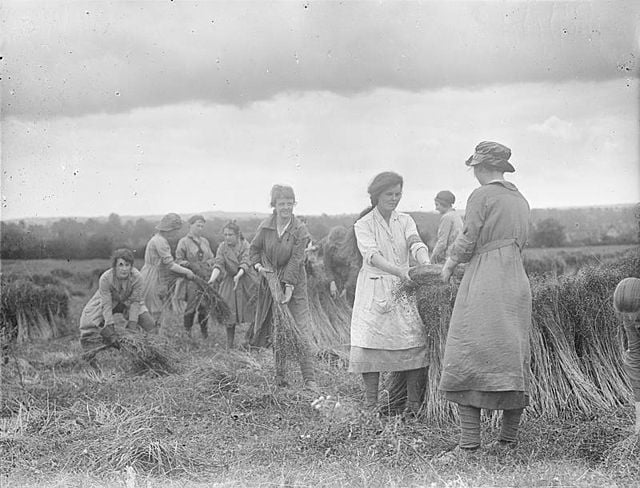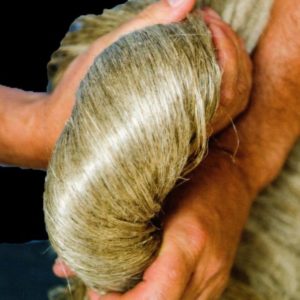Crafts, Fabric & fibre, Farming, Faxipedia, Flax Museum
Flax growing for linen
Flax for linen
In the UK Linum Usitatissimum is “linseed” and “flax”. Different varieties have been developed over millennia some are better for producing seeds, which we call linseed and others, taller with finer fibre in the stems for making linen, the is flax. Both linseed and flax have blue flowers.
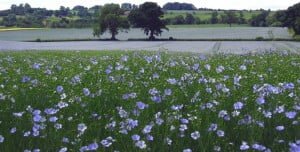
“Flax” means different things to different people. In the UK flax refers to the long fibres in the stems of the varieties of the plant Linum Usitatissimum grown to make linen. Linum Usitatissimum is also the name of the plant grown for linseed for eating. In the UK no one used to call linseed for eating flax.
It is often a surpise to people that flax can be grown in the UK. Flax used to be grown over the whole of the UK. It produced linen which was the only alternative to wool for most people until cotton became common. Calico, a cheap cotton fabric made in India was initially banned from 1721 for twenty years by the Calico act to protect the linen industry. In UK flax growing fell out popularity between the wars. There was a resurgence of interest in the crop during WW2 when it was needed for parachutes and to keep us self-sufficient in fibre for ropes. After the second world war flax was no longer grown in the UK apart from Northern Ireland which used to be famous for its linen and was a major industry. Linen production ceased in Norther Ireland in 2009 . Even there flax growing has ceased and now is only grown by a few hobby farmers.
Before the eighteenth century linen was the only option for summer shirts, undergarments and bed linen. Linen is a very superior fabric for comfort. The long fibres produce a fabric that is hard-wearing and cool to wear in hot weather. In Sussex, linen smocks were famously worn by Shepherds. These tough garments helped give protection from wind and could last a working man for ten years.
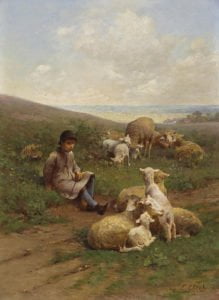
Easy to grow your own clothes
Flax grows in most ordinary and unimproved soils. It appreciates moist soil especially to get it started though once it has its roots down it is very good for finding moisture. Usually a trouble-free crop. It doesn’t appreciate weed competition so needs careful weeding especially early in the growing season. It doesn’t require fertilising on most soils, indeed a soil that is too rich can cause the stems to grow too tall weak and lanky which makes them prone to falling over or “lodging”.
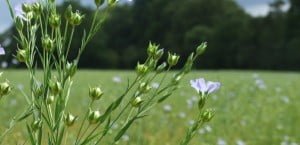
Famed for its beautiful flowers, which it has in common with most linseed varieties a field of flax can easily be mistaken for a lake. The flowers last just one day before the petals fall, leaving the seeds to start swelling in the capsule. When the capsules are swelling and ripening they are called “bolls” Each boll potentially contains five pairs of seeds but if fertilisation of the flowers was less than perfect fewer seeds develop and you may find only six or eight seeds in the capsule.
Three square metres can produce enough linen for a couple of tea towels. A plot of 40 square would produce enough linen to make a shirt. So you can see it would have been relatively easy for even peasants to grow enough flax to keep themselves in linen shirts, smocks and underclothes.
If you read the delightful children’s book “How a Shirt Grew in the Field” K. D Ushinskiai you will learn all the stages of growing enough flax to make into a linen shirt. It’s a lovely children’s story and gently educational, easily bought secondhand from book dealers.
Approximately 100 days after sowing the crop is ready to harvest. Unlike cereals which are cut and combine harvested, flax is pulled. The whole plant with roots is pulled out so the longest possible fibres can be extracted from the plant. Puling was done by hand until relatively recently, during the first half of the twentieth-century flax pulling machinery was starting to be developed.
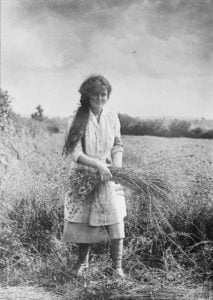
A female “land army” farm worker, “land girl” pulling flax on a farm in Yeovil, Somerset.
Processing Flax
After the flax has been pulled it is usually left bundled in stooks in the field to dry.
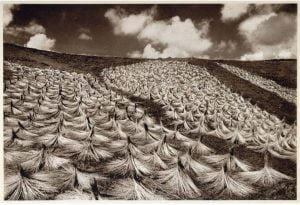
Once dry the seeds are removed and though edible they don’t store well for food purposes. These seeds are called linseed, they are pressed for linseed oil but this is the quality suited for cricket bats and industrial purposes, not nice or healthy, very different from Flax Farm’s cold-pressed linseed oil.
After that, the process of removing the pulpy matter from the flax fibres is started. First, the flax is “retted” which is the process of rotting the soft material in the stems. Retting can be as simple as leaving it for a few days on damp grass or it is put in specially built ponds. In the past flax was commonly retted in rivers where the rotting process sadly deoxygenated and poisoned the water.
The retted flax is then dried and goes through a series of mechanical processes to remove the dried retted non-fibrous material from the flax fibres. This includes breaking, scutching and heckling or hackling. In the past, they used very simple primitive homemade tools for these processes.
This results in long silky blonde, fibres; it’s where we get the word flaxen from.. These fibres are spun either by hand or using a spinning wheel into a thread that can then be woven into linen. Job done!
Flax Linen words.
- Linseed
- Boll
- Ripen
- Harvest
- Pull
- Dry
- Bundle
- Truss
- Stook
- Ripple
- Thresh
- Rett
- Break
- Scutch
- Hackle
- Heckle
- Spin
- Tow
- Weave

